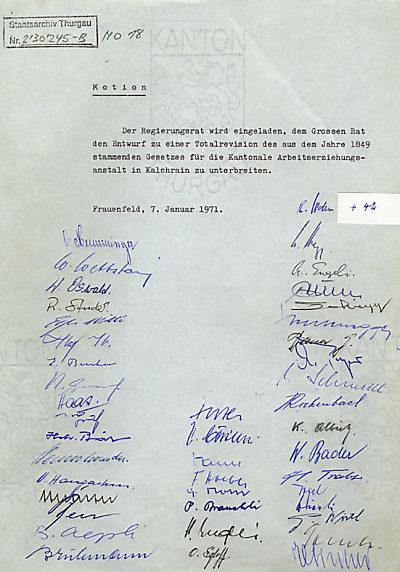Weber Motion for complete revision of the Kalchrain Act of 1849
 Weber, Rolf: Motion for complete revision of the Kalchrain Act of 1849 to the Government Council of the canton of Thurgau, 7 January 1971
Weber, Rolf: Motion for complete revision of the Kalchrain Act of 1849 to the Government Council of the canton of Thurgau, 7 January 1971 In grounding the motion, Weber stated that since the time when the law was originally adopted in 1849 significant changes had been made to the legal bases relating to the purpose of the Kalchrain Correctional Labour Facility (renamed in 1943 as the Juvenile Correctional Labour Facility). He further pointed out that a revision of the law was called for also by current socio-political developments and by changes that had taken place at the Kalchrain facility itself over the course of the nearly 125-year existence of the Kalchrain Act.
About the author of the motion
After completing his studies at the University of Bern (1942-1948), Dr. Rolf Weber (1923-2000) worked as a lawyer in the canton of Thurgau. As a member of the Social-Democratic Party (SP), he was also active for many years in cantonal and federal politics. In 1953 he was elected to the cantonal assembly (Grand Council) of the canton of Thurgau (1953); from 1971 to 1987 he also represented the canton in the Federal Assembly as a member of the National Council. Throughout his career, Weber showed a particular interest in constitutional issues. Among the major projects he was involved in as a member of the cantonal assembly were the passage of the Welfare Act of the Canton of Thurgau (1966) and the revision of the canton’s criminal procedure code in 1971.
Research questions
As an historical source, the Weber motion provides insight, among other things, into the workings of the political processes within the government of the Canton of Thurgau. It provides an illustration of the kinds of political efforts that led to the gradual delegitimisation of the use of administrative detention, up to the point where it was finally abolished entirely. In this context there are many questions that arise. What were the demands that the advocates of the motion posed to the government? How did the two councils (the Cantonal Council and the Government Council) go about responding to the motion? What were the arguments put forth in support of revision of the law that established the Kalchrain facility in 1849? What were the arguments of those who opposed such a revision? Some of these questions can be answered by consulting the records of the Government Council relating the Weber Motion.
The source also raises important questions concerning the political and social developments that led to the ultimate repeal of the laws on administrative detention. It is possible to investigate such questions, for example, as whether voices critical of the 1849 law, or of the Kalchrain correctional labour facility itself, were also raised at an earlier point in time. Another question that can be asked is why the law in Thurgau – as opposed to various similar laws in other cantons – had not undergone any revision since its original passage in 1849 (other than renaming of the Kalchrain Correctional Labour Facility as the Juvenile Correctional Labour Facility in 1943).
In addition to having many other repercussions, the motion by Rolf Weber also played an important role in the wider reform process that was set in motion by the revision of the 1849 Kalchrain Act. Thus, for example, on 5 July 1976, the Government Council issued a far-reaching ordinance on the execution of criminal sentences and other detention measures in the Kalchrain facility, in the cantonal prison, and in district prisons. With that ordinance, the statutory basis for the practice ordering detentions on the grounds of an individual’s «dissolute», «indolent» or «licentious» way of life was abrogated. Therefore, the Canton of Thurgau abolished non-medically justified administrative detention in 1976 — while administrative detention continued to exist in psychiatric clinics and institutions for the treatment of alcoholism — five years before it was abolished throughout Switzerland in 1981.
N. Gönitzer/Translation
Source
Weber, Rolf: Motion for complete revision of the Kalchrain Act of 1849 to the Government Council of the canton of Thurgau, 7 January 1971.
Signature: Staatsarchiv Thurgau (StATG): 2’30’245-B, MO 18.
 previous source
previous source
 next source
next source


